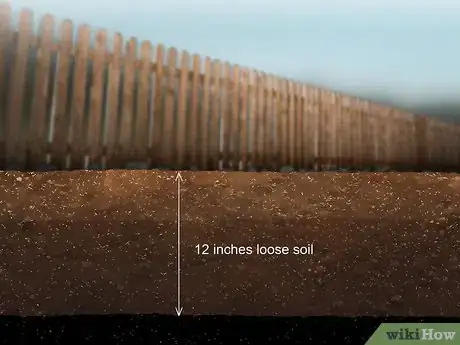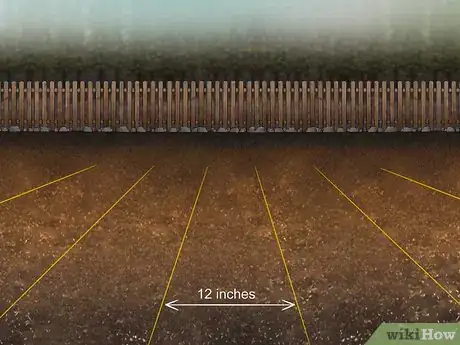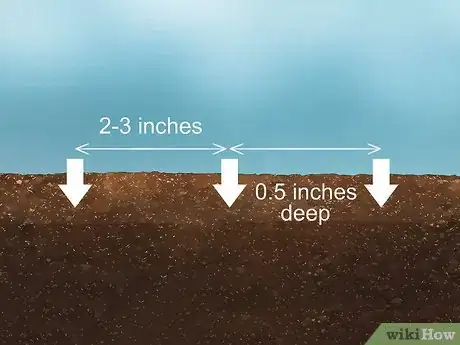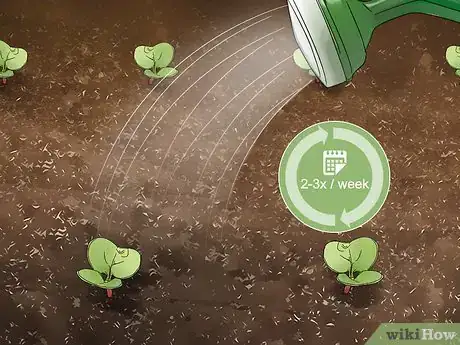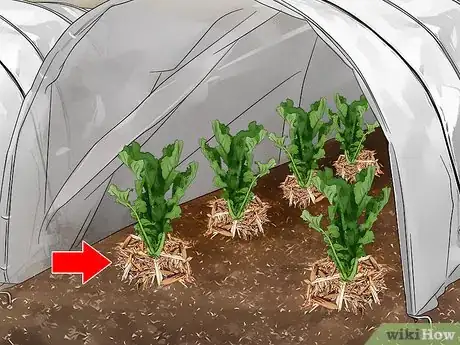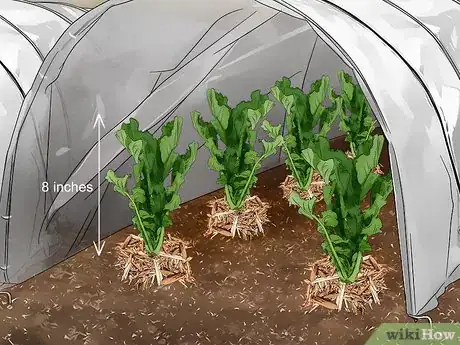This article was co-authored by wikiHow Staff. Our trained team of editors and researchers validate articles for accuracy and comprehensiveness. wikiHow's Content Management Team carefully monitors the work from our editorial staff to ensure that each article is backed by trusted research and meets our high quality standards.
This article has been viewed 50,011 times.
Learn more...
Daikon is a radish that also produces edible microgreens. You can grow daikon like most root vegetables, in a garden bed outdoors or in a planter or pot indoors. Your daikon seedlings will need lots of sun, water, and protection from pests. When they are ready to harvest, you can use the greens and radishes raw or cooked for a great healthy addition to your meals!
Steps
Planting the Seeds
-
1Plant daikon seeds in late summer or fall. Daikon radishes do best when they are planted in cool weather. When you plant will depend on the climate where you live. For example, if you live in a climate where the temperatures do not start to drop until December, then planting in October might be best. If temperatures start to drop in April, then you might want to plant in February.[1]
- Checking the temperature of the soil can help you to determine the best time to plant. The soil temperature should be between 60 to 85 °F (16 to 29 °C) for optimal germination.[2]
- Stick a soil thermometer about 6 inches (15 cm) into the soil to check the temperature. If the soil is hard, then use a screwdriver to poke a hole through the soil first.[3]
-
2Select a spot with loosely-packed soil. A loosely-packed garden bed (raised or at ground level) or a pot with loosely-packed soil is ideal for growing daikon. The soil will need to be loose far down enough to support daikon growth, so check to ensure that you will have at least 12 inches (30 cm) of loosely-packed soil where you will be growing daikon.[4]
- If the soil is tightly-packed, then you can loosen it with a garden fork.[5] Dig the garden fork into the ground and then tilt it and bring it back up through the soil. Do this as many times as needed to loosen the soil.
- If you are planting daikon in pots or a planter, avoid packing the soil down. Just pour it in and do not press on it.
Advertisement -
3Make sure the radishes will get full sun for at least 8 hours per day. Choose a sunny location in your garden to grow daikon in the ground.[6] If you will be growing daikon indoors, then place the container next to a south-facing window or purchase a grow light to place the daikon under.[7]
- To find a sunny spot in your yard, go outside at various times of the day to see where the sun is shining. For example, you could go outside at 8:00 am, 12:00 pm, and 4:00 pm to check the location of the sunlight in your yard.
-
4Create rows that are 8 to 12 inches (20 to 30 cm) apart. Daikon radishes need room to grow, so make sure that you are spacing out your rows by 8 to 12 inches (20 to 30 cm). You can grow radishes in all of the rows, or grow daikon in 1 row and grow a different crop in the next row.[8]
- If you are planting daikon in a long planter or wide pot, then you may only have room for 1 row.
-
5Plant seeds 2 to 3 inches (5.1 to 7.6 cm) apart and 0.5 in (1.3 cm) deep. Daikon seeds do not need to be planted very deep to germinate, so just make a small hole or series of holes in your row or pot. Space the holes out by 2 to 3 inches (5.1 to 7.6 cm).[9]
- For faster germination, you can soak the seeds in clean, tepid water for 8 hours.[10]
Caring for the Seedlings
-
1Thin out the seedlings after they sprout. There should only be 1 seedling every 5 to 6 inches (13 to 15 cm). Once the seedlings have sprouted, you may need to thin them out to ensure that they are not overcrowded. There should only be 1 seedling every 5 to 6 inches (13 to 15 cm) apart. Use scissors to cut the stems of any extra seedlings just above the ground level.[11]
- You can eat the leaves of the seedlings that you cut. These are the daikon’s microgreens and they have a pleasant peppery flavor.
-
2Water the daikon 2 to 3 times per week. Daikon radishes need to be watered regularly to ensure that they will grow. Check the soil every couple of days to ensure that it has adequate moisture.[12]
- To check the soil, stick your finger into it by about 1 inch (2.5 cm). If the soil feels dry, then you should water the daikon. If it feels moist, then you can leave it be for another day.
- If you are growing daikon for microgreens, then you can simply mist the soil with a spray bottle of water. This will help to ensure that the seeds are undisturbed.
-
3Cover seedlings with a crop cover to protect the leaves. If you are concerned about insects getting to your daikon, you can place a crop cover over the seedlings. These are mesh covers that go right over the plants. They are available at garden centers.[13]
- You may want to anchor the crop cover to ensure that it stays put on windy days. Place heavy rocks or bricks along the edges of the crop cover.
-
4Add a 1 to 2 in (2.5 to 5.1 cm) deep layer of hay mulch. Seedlings will die if it gets too cold, which is why it is important to plant before the temperatures drop too low. However, you may have a night here and there when the temperatures drop into the freezing range. Covering the seedlings with a layer of hay mulch will help to insulate them and protect them from the cold.[14]
- If temperatures are already into the freezing range, your daikon will be safer in a planter or pot indoors.
Harvesting Daikon
-
1Cut microgreens when they are about 2 inches (5.1 cm) in height. Microgreens are the small leaves that sprout up from the ground before the daikon radishes form. You can harvest and eat these small leaves. Use a pair of sharp scissors or garden shears to snip the leaves about 0.5 in (1.3 cm) from the ground.[15]
- Daikon microgreens are great raw or cooked. Add them to a salad, throw a handful into a smoothie, or stir-fry them with some other fresh veggies.
-
2Harvest the daikon leaves when they are 8 inches (20 cm). Your daikon radishes should be ready to harvest when the tops have grown to a length of 8 inches (20 cm). Use a measuring tape to determine their length. Check them regularly when you think they are getting close and pull them up as soon as they are ready.[16]
- You can eat daikon radishes raw or cooked. Peel, slice, and toss some in a salad or stir-fry.
- Leaving the radishes in the ground too long will cause them to get woody and they may not be edible.
-
3Pull up the remaining radishes before the ground freezes. If you have any daikon that are still growing when the temperature start to dip below freezing, pull them up. The longer the daikon stay in the ground when it starts to get cold, the higher the chance that they will rot.[17]
Things You’ll Need
- Daikon seeds
- Garden bed or pots
- Potting soil
- Garden fork
- Spade
- Watering can or spray bottle
- Hay
- Grow light (optional)
References
- ↑ http://sonomamg.ucanr.edu/The_Kitchen_Garden/Feature_Vegetables/Daikon/
- ↑ http://www.stoverseed.com/PDFs/Radish_Daikon_Cultural_8-12.pdf
- ↑ https://www.todayshomeowner.com/how-to-measure-soil-temperature-for-planting/
- ↑ http://sonomamg.ucanr.edu/The_Kitchen_Garden/Feature_Vegetables/Daikon/
- ↑ http://www.stoverseed.com/PDFs/Radish_Daikon_Cultural_8-12.pdf
- ↑ http://www.stoverseed.com/PDFs/Radish_Daikon_Cultural_8-12.pdf
- ↑ https://www.healwithfood.org/grow-indoors/daikon-microgreens-kaiware-sprouts.php
- ↑ http://www.stoverseed.com/PDFs/Radish_Daikon_Cultural_8-12.pdf
- ↑ http://www.stoverseed.com/PDFs/Radish_Daikon_Cultural_8-12.pdf
- ↑ https://www.healwithfood.org/grow-indoors/daikon-microgreens-kaiware-sprouts.php
- ↑ http://www.stoverseed.com/PDFs/Radish_Daikon_Cultural_8-12.pdf
- ↑ http://www.stoverseed.com/PDFs/Radish_Daikon_Cultural_8-12.pdf
- ↑ http://www.stoverseed.com/PDFs/Radish_Daikon_Cultural_8-12.pdf
- ↑ http://www.stoverseed.com/PDFs/Radish_Daikon_Cultural_8-12.pdf
- ↑ https://www.healwithfood.org/grow-indoors/daikon-microgreens-kaiware-sprouts.php
- ↑ http://www.stoverseed.com/PDFs/Radish_Daikon_Cultural_8-12.pdf
- ↑ http://www.stoverseed.com/PDFs/Radish_Daikon_Cultural_8-12.pdf

